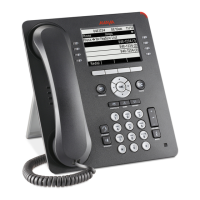System Failover and Survivability
156 Deskphone SIP 9608, 9611G, 9621G, 9641G Administrator Guide Release 6.0.1
ringing. An incoming call will be ended when the link between the Session Manager that routed
the call and the phone has gone down. For example, if the deskphone has a primary SM (SM1)
and a secondary SM (SM2), and receives a call directly from the secondary SM but SM2 goes
down, the call that was received from SM2 is terminated.
Media preservation only keeps shuffled calls or calls using direct media between endpoints up
with a direct RTP stream until the call has ended. The user can only put this call on Hold,
resume the call, or end the call. The user can also answer any incoming call and the media
preserved call will be put on hold.
User experience during stable failover
●
A Failover “warning” icon displays on the top line. The Failover icon is shown whenever
the primary call server is not active. The Failover icon provides a continuous reminder
indicating the deskphone has detected that the primary server is unavailable and that
features will be limited until the primary server returns.
●
Multiple Call Appearances are consistent with Normal Operation.
●
If a call originates using the secondary server, Hold, Conference and Transfer are
supported.
●
AST features (FNUs and Bridged call appearances) are unavailable when failing over to a
secondary gateway.
●
Unsupported features and related softkeys are not displayed.
●
The dial plan does not remain as it was in normal operation. The dial plan in failover is set
with the DIALPLAN parameter which should contain all needed strings while failed over.
Calls between sets in the branch are supported, using their usual extensions.
●
Outgoing Calls that would normally route to the SES or SM/CM will instead be routed to
the local gateway.
●
Emergency calls (to the provisioned emergency numbers as defined in the dial plan) will
be permitted whether those phones are in failover or normal mode. The Emergency
softkey is available when a new controller is found.
●
The MWI (Message Waiting Indicator) will be cleared, but voice mail is still available.
●
One-button voice mail access will be available if the central voice mail system continues to
operate and will make a PSTN call to the voice mail system. Depends on correct
provisioning.
●
Local deskphone features will be available: audio selection (speaker / headset / handset),
mute.
●
Local phone applications will be available: local call redial, Call Logs, Volume Control,
local contacts, speed-dials, auto-dials, WML browser (WML Browser is dependent on
network access to the WML server) but cannot be changed.

